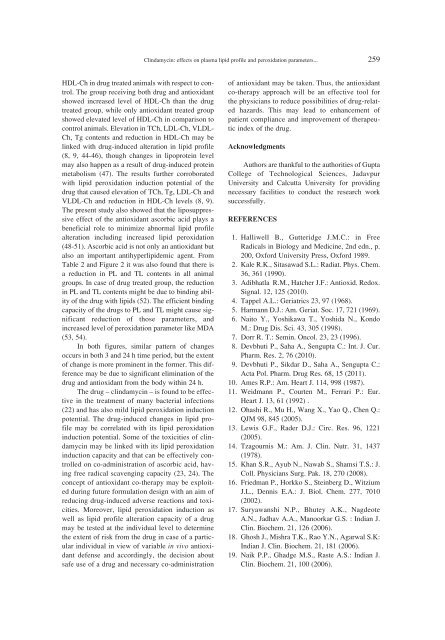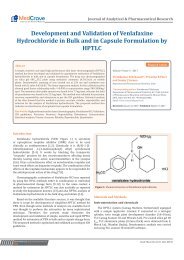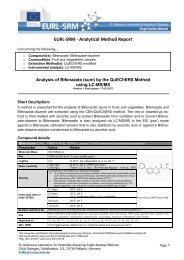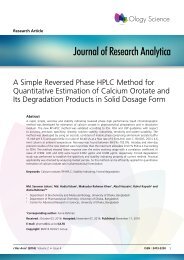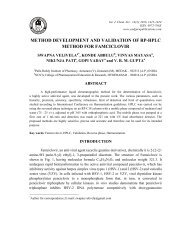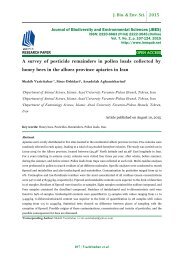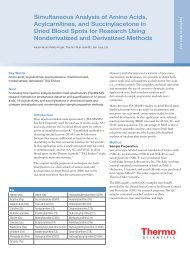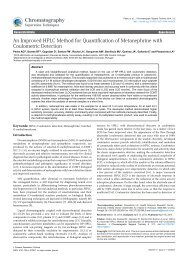acta 2_2015
acta 2_2015
acta 2_2015
- No tags were found...
Create successful ePaper yourself
Turn your PDF publications into a flip-book with our unique Google optimized e-Paper software.
Clindamycin: effects on plasma lipid profile and peroxidation parameters... 259HDL-Ch in drug treated animals with respect to control.The group receiving both drug and antioxidantshowed increased level of HDL-Ch than the drugtreated group, while only antioxidant treated groupshowed elevated level of HDL-Ch in comparison tocontrol animals. Elevation in TCh, LDL-Ch, VLDL-Ch, Tg contents and reduction in HDL-Ch may belinked with drug-induced alteration in lipid profile(8, 9, 44-46), though changes in lipoprotein levelmay also happen as a result of drug-induced proteinmetabolism (47). The results further corroboratedwith lipid peroxidation induction potential of thedrug that caused elevation of TCh, Tg, LDL-Ch andVLDL-Ch and reduction in HDL-Ch levels (8, 9).The present study also showed that the liposuppressiveeffect of the antioxidant ascorbic acid plays abeneficial role to minimize abnormal lipid profilealteration including increased lipid peroxidation(48-51). Ascorbic acid is not only an antioxidant butalso an important antihyperlipidemic agent. FromTable 2 and Figure 2 it was also found that there isa reduction in PL and TL contents in all animalgroups. In case of drug treated group, the reductionin PL and TL contents might be due to binding abilityof the drug with lipids (52). The efficient bindingcapacity of the drugs to PL and TL might cause significantreduction of those parameters, andincreased level of peroxidation parameter like MDA(53, 54).In both figures, similar pattern of changesoccurs in both 3 and 24 h time period, but the extentof change is more prominent in the former. This differencemay be due to significant elimination of thedrug and antioxidant from the body within 24 h.The drug ñ clindamycin ñ is found to be effectivein the treatment of many bacterial infections(22) and has also mild lipid peroxidation inductionpotential. The drug-induced changes in lipid profilemay be correlated with its lipid peroxidationinduction potential. Some of the toxicities of clindamycinmay be linked with its lipid peroxidationinduction capacity and that can be effectively controlledon co-administration of ascorbic acid, havingfree radical scavenging capacity (23, 24). Theconcept of antioxidant co-therapy may be exploitedduring future formulation design with an aim ofreducing drug-induced adverse reactions and toxicities.Moreover, lipid peroxidation induction aswell as lipid profile alteration capacity of a drugmay be tested at the individual level to determinethe extent of risk from the drug in case of a particularindividual in view of variable in vivo antioxidantdefense and accordingly, the decision aboutsafe use of a drug and necessary co-administrationof antioxidant may be taken. Thus, the antioxidantco-therapy approach will be an effective tool forthe physicians to reduce possibilities of drug-relatedhazards. This may lead to enhancement ofpatient compliance and improvement of therapeuticindex of the drug.AcknowledgmentsAuthors are thankful to the authorities of GuptaCollege of Technological Sciences, JadavpurUniversity and Calcutta University for providingnecessary facilities to conduct the research worksuccessfully.REFERENCES1. Halliwell B., Gutteridge J.M.C.: in FreeRadicals in Biology and Medicine, 2nd edn., p.200, Oxford University Press, Oxford 1989.2. Kale R.K., Sitasawad S.L.: Radiat. Phys. Chem.36, 361 (1990).3. Adibhatla R.M., Hatcher J.F.: Antioxid. Redox.Signal. 12, 125 (2010).4. Tappel A.L.: Geriatrics 23, 97 (1968).5. Harmann D.J.: Am. Geriat. Soc. 17, 721 (1969).6. Naito Y., Yoshikawa T., Yoshida N., KondoM.: Drug Dis. Sci. 43, 305 (1998).7. Dorr R. T.: Semin. Oncol. 23, 23 (1996).8. Devbhuti P., Saha A., Sengupta C.: Int. J. Cur.Pharm. Res. 2, 76 (2010).9. Devbhuti P., Sikdar D., Saha A., Sengupta C.:Acta Pol. Pharm. Drug Res. 68, 15 (2011).10. Ames R.P.: Am. Heart J. 114, 998 (1987).11. Weidmann P., Courten M., Ferrari P.: Eur.Heart J. 13, 61 (1992) .12. Ohashi R., Mu H., Wang X., Yao Q., Chen Q.:QJM 98, 845 (2005).13. Lewis G.F., Rader D.J.: Circ. Res. 96, 1221(2005).14. Tzagournis M.: Am. J. Clin. Nutr. 31, 1437(1978).15. Khan S.R., Ayub N., Nawab S., Shamsi T.S.: J.Coll. Physicians Surg. Pak. 18, 270 (2008).16. Friedman P., Horkko S., Steinberg D., WitziumJ.L., Dennis E.A.: J. Biol. Chem. 277, 7010(2002).17. Suryawanshi N.P., Bhutey A.K., NagdeoteA.N., Jadhav A.A., Manoorkar G.S. : Indian J.Clin. Biochem. 21, 126 (2006).18. Ghosh J., Mishra T.K., Rao Y.N., Agarwal S.K:Indian J. Clin. Biochem. 21, 181 (2006).19. Naik P.P., Ghadge M.S., Raste A.S.: Indian J.Clin. Biochem. 21, 100 (2006).


